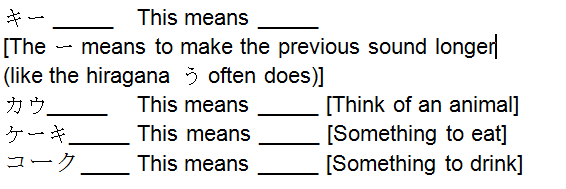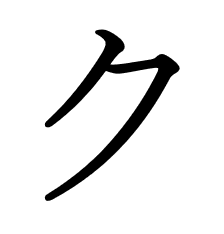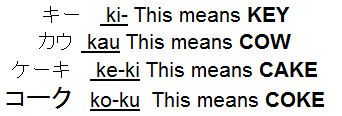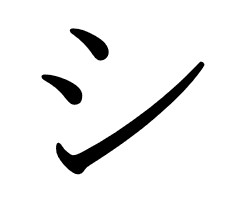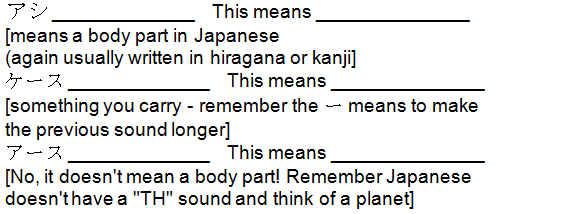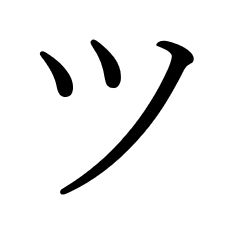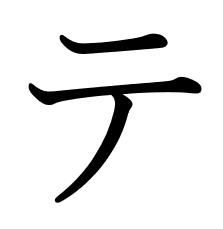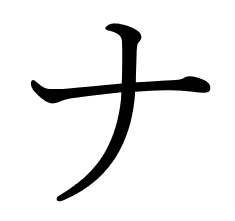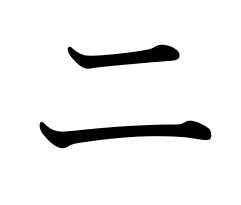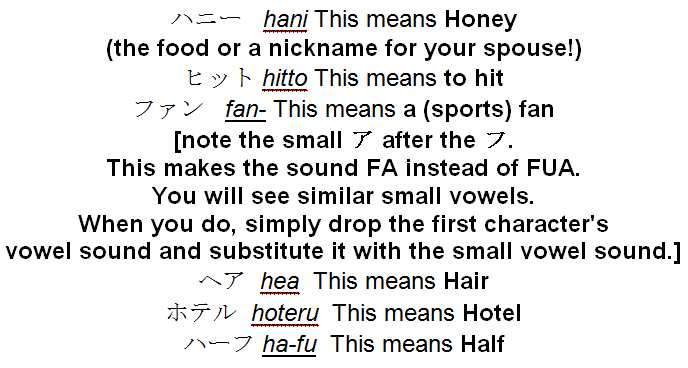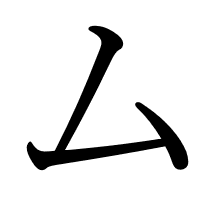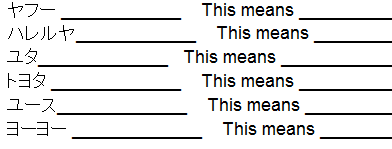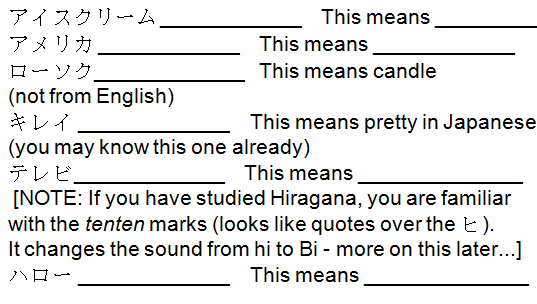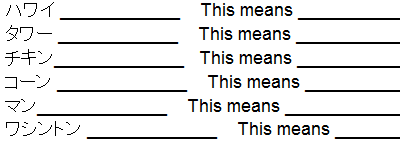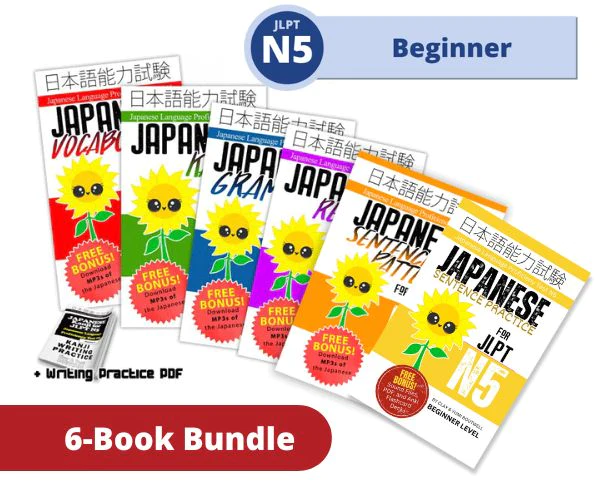This page assumes you've learned hiragana. If you prefer to learn katakana first, no problem, but first go through the first section of our hiragana pages (the sounds) before starting this page. Already know katakana but need practice? Click here for our Katakana Practice Quiz.
Support us directly and get amazing benefits to help with your language learning.
A FEW POINTS
- Katakana is known as the more "masculine" of the Japanese writing systems. This is because most of the characters are rigid and have sharp turns.
- Katakana is mainly used for foreign loan-words, non-Japanese names, and onomatopoeia (sound effects). For example: Cola is コーラ ko-ra. You will notice the dash in the middle. This makes the コ ko longer in sound. If this were to be written in Hiragana, it would look like: こうら koura. (In Hiragana the u lengthens the previous character) Other than that, Hiragana and Katakana work and sound in the same way.
- Most sounds in Japanese are found also in English. Unlike English, the "letters" in Japanese only have one sound, with a few exceptions that will be mentioned later on.
- Please download the sound files to get a feel for the sounds before beginning (see last page).
- In modern Japanese, there are 45 main katakana, one less than hiragana since the "wo" katakana isn't used much today.
- The most important to master are the vowels (the first row). These sounds are all found in English and they are the same as the vowel sounds in Spanish.
THE CHART Spend a few moments and you should be able to see a clear pattern. The columns are the vowels and the rows are the consonants. The first row has no consonant, so those characters represent only vowel sounds: A, I, U, E, and O. The second row is the "K" row, so the order would be KA, KI, KU, KE, and KO. There are only a few exceptions which we will get to.
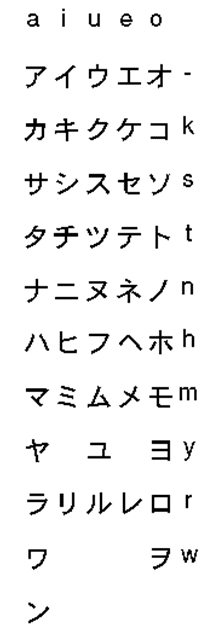
Katakana
アイウエオ
- Rōmaji: A
- Sounds like: fAther or cAr or Ah
Mnemonic:
- It looks like a capital A leaning over (doing exercises).
2 strokes
- Rōmaji: I
- Sounds like: i - as in "fEEt"
Mnemonic:
- It looks like a lowercase “i” with a hat on instead of a dot.
2 strokes
- Rōmaji: U
- Sounds like: as in "fOOd"
Mnemonic:
- It looks like a mouth about to eat fOOd.
You may be tempted to write this next one in two strokes but try to follow the correct stroke order.
3 strokes
- Rōmaji: E
- Sounds like: "eh?" or "hAte"
Mnemonic:
- It looks like a capital “I” but it really is an Eh sound.
3 strokes
- Rōmaji: O
- Sounds like: o - as in "knOw"
Mnemonic:
- It looks like someone kicking something "OH OH!"
3 strokes
Chapter Test
How do you read the following Katakana characters? These are all English words.
カキクケコ
- Rōmaji: KA
- Sounds like: CAr
Mnemonic:
- It looks like the hiragana ka か just remove the hanging line.
2 strokes
- Rōmaji: KI
- Sounds like: KEY
Mnemonic:
- It looks like a hiragana ki き without the base.
3 strokes
- Rōmaji: KU
- Sounds like: COOl
Mnemonic:
- It looks like a guy giving a thumbs-up. That's COol!
2 strokes
- Rōmaji: KE
- Sounds like: KAY or CAke
Mnemonic:
- It looks like someone's CApe.
3 strokes
- Rōmaji: KO
- Sounds like: COld
Mnemonic:
- It looks like a refrigerator door; that's COld!
2 strokes
Chapter Test
How do you read the following Katakana characters? These are all English words.
サシスセソ
- Rōmaji: SA
- Sounds like: SOlitude
Mnemonic:
- It looks like a squished SAw blade.
If you know hiragana, be careful with this one. It looks like a backwards hiragana se せ.
3 strokes
- Rōmaji: SHI
- Sounds like: SHE
Mnemonic:
- It looks like someone pulling down a SHEEt from a closet.
- SHE always smiles, tilting her head.
Here is the first irregular pronunciation. You would think it would be "si" and Japanese often Romanize it as "si," but it is pronounced as "shi" (like the English pronoun "she").
3 strokes
- Rōmaji: SU
- Sounds like: SUE
Mnemonic:
- It looks like SUE standing with her legs apart.
2 strokes
- Rōmaji: SE
- Sounds like: SAY
Mnemonic:
- Say, it looks like someone with a huge mouth SAYing something.
2 strokes
- Rōmaji: SO
- Sounds like: SO
Mnemonic:
- It looks like someone is touching something on a pedestal. It's SO pretty.
Be careful with this one. There is another katakana (the ン n character) that looks very similar. ソ so is an abbreviation of the そ (hiragana so) therefore the longer stroke starts at top. The stroke for ン n starts at the bottom.
Sometimes, also, the eye looks down at something with so (ソ). With n (ン) it is usually tilted horizontally. While it is easy to confuse the two, you'll find it easier to discern as you learn their individual usages.
2 strokes
Chapter Test
How do you read the following Katakana characters? These are all English words.
タチツテト
- Rōmaji: TA
- Sounds like: TOm
Mnemonic:
- It looks like an invisible TOm boy hitting a TAmbourine (the American pronunciation of "tambourine" is a little off but say it with a "tah" pronunciation).
3 strokes
- Rōmaji: CHI
- Sounds like: CHEEze
Mnemonic:
- It is a CHEAp and CHEEzy umbrella turned inside out.
3 strokes
- Rōmaji: TSU
- Sounds like: caT SOUp
Mnemonic:
- It looks like someone politely smiling at you after hearing you say "cat soup" thirty times really fast.
And now we come to perhaps the hardest character to pronounce in Japanese! It is also irregular. You would expect this to be tu but it is tsu. This is the sound in "tsunami" (a loanword from Japanese). A good way to get this sound is saying "Cat Soup" quickly. The "T Sou" part is the approximate sound but listen to the sound file and mimic what you hear.
3 strokes
- Rōmaji: TE
- Sounds like: TApe
Mnemonic:
- It looks like someone is putting down a roll of TApe.
3 strokes
- Rōmaji: TO
- Sounds like: TOE
Mnemonic:
- It looks like someone is kicking something with their TOE.
2 strokes
Chapter Test
How do you read the following Katakana characters? These are all English words.
ナニヌネノ
- Rōmaji: NA
- Sounds like: NOt
Mnemonic:
- It looks like someone is NOdding off for a nap.
2 strokes
- Rōmaji: NI
- Sounds like: NEAt or KNEE
Mnemonic:
- It is someone on his KNEEs getting ready to write the ChiNEse kanji for the number two.
If you remember, the number two in Japanese is "ni." This character has two lines. In fact, the kanji for the number two looks pretty much the same as the katakana.
2 strokes
- Rōmaji: NU
- Sounds like: NEW
Mnemonic:
- It looks like a brand-NEW scythe.
2 strokes
- Rōmaji: NE
- Sounds like: NEIGHbor
Mnemonic:
- It looks like a cross-section of a NAval ship. Or an arm growing out of your NEIGHbor's NAvel.
4 strokes
- Rōmaji: NO
- Sounds like: NO
Mnemonic:
- It looks like the curve of someone's NOse.
1 stroke
Chapter Test
How do you read the following Katakana characters? These are all English words.
ハヒフヘホ
- Rōmaji: HA
- Sounds like: HA!
Mnemonic:
- It looks like a capital "H" laughing "HA!" so loud that its middle fell off.
2 strokes
- Rōmaji: HI
- Sounds like: HE
Mnemonic:
- HE is sitting down with his arms out.
2 strokes
- Rōmaji: FU
- Sounds like: FOOd
Mnemonic:
- It looks like the end of someone's FOOt.
1 stroke
- Rōmaji: HE
- Sounds like: HEY!
Mnemonic:
- It looks the same as the hiragana HE!
This one-stroke character is pretty much the same as the hiragana (although your computer actually uses a different character when typed). It is also used as a directional marker: I'm going to the store. mise he ikimasu. (but when used as a marker, it tends to sound more like e than he.
1 stroke
- Rōmaji: HO
- Sounds like: HOE
Mnemonic:
- It looks like two people scraping a HOE into the ground in a field.
If you are familiar with the kanji for tree 木 (ki), you can make some mnemonic with that. But remember the two branches do not touch the trunk of the HO tree.
4 strokes
Chapter Test
How do you read the following Katakana characters? These are all English words.
マミムメモ
- Rōmaji: MA
- Sounds like: MAMA
Mnemonic:
- It looks like MAma kicking someone out with her foot.
2 strokes
- Rōmaji: MI
- Sounds like: MEEt
Mnemonic:
- It looks like a MEteor shower.
If you know the kanji for the number three (三), this is similar. Also, one of the pronunciations to say the number three is "mi." This katakana has three strokes and three lines.
3 strokes
- Rōmaji: MU
- Sounds like: MOOd
Mnemonic:
- It is an upside-down katakana ma マ, pronounced mu.
2 strokes
- Rōmaji: ME
- Sounds like: MAY
Mnemonic:
- It looks like a man with his legs tied. He MAY fall if he doesn't stop leaning over.
- Perhaps you can remember this one as a line through the katakana no character: ノ
2 strokes
- Rōmaji: MO
- Sounds like: MOE
Mnemonic:
- It looks like a lawn MOWer.
3 strokes
Chapter Test
How do you read the following Katakana characters? These are all English words.
ヤユヨ
- Rōmaji: YA
- Sounds like: hiYA!
Mnemonic:
- It looks like a YAk that stepped on something.
This row only has three characters. This is because yi and ye are not used in modern Japanese.
2 strokes
- Rōmaji: YU
- Sounds like: YOU
Mnemonic:
- It looks like a number one: YOU are #1!
2 strokes
- Rōmaji: YO
- Sounds like: YO!
Mnemonic:
- It looks like a backwards E. YO, what's up with that?
3 strokes
Chapter Test
How do you read the following Katakana characters? These are all English words.
ラリルレロ
- Rōmaji: RA
- Sounds like: hoRAH!
Mnemonic:
- It looks like a monster yelling, "RAA!"
2 strokes
- Rōmaji: RI
- Sounds like: REal
Mnemonic:
- It looks like a REpeat of the hiragana い i but flipped around.
2 strokes
- Rōmaji: RU
- Sounds like: RUE
Mnemonic:
- It looks like someone putting his or her foot out to trip someone. How RUde!
2 strokes
- Rōmaji: RE
- Sounds like: RAY
Mnemonic:
- It looks like a RAY of light.
1 stroke
- Rōmaji: RO
- Sounds like: ROW
Mnemonic:
- It looks like a tunnel on the ROad.
The kanji for "mouth" looks very similar to the katakana ro—just a box.
3 strokes
Chapter Test
How do you read the following Katakana characters? These are all English words.
ワヲン
- Rōmaji: WA
- Sounds like: WAnd
Mnemonic:
- It looks like a baby with only one tooth crying, "WA!!!"
Be careful with the katakana u sound (ウ); they are very similar. wa doesn’t have a hat on.
2 strokes
- Rōmaji: WO
- Sounds like: WOE
Mnemonic:
- It looks like a double-bladed sword; WOE to the enemy!
This character isn't used much, but you may see it in place of を when a whole sentence is written in katakana (like an old-fashioned telegram). In other words, don't worry about memorizing this character. Just knowing its existence is probably enough.
3 strokes
- Rōmaji: N
- Sounds like: nnnN
Mnemonic:
- It looks like a one-eyed joker just smiliN'
2 strokes
Chapter Test
How do you read the following Katakana characters? These are all English words.
Wrapping up Katakana Part I
Adding the Ten Ten
A "ten-ten" looks like a double quote ("). It changes the sound of the character to a harder sound. You can ONLY "ten-ten" the "K" row, the "S" row, the "T" row, and the "H" row.
A "maru" is the tiny circle that makes H sounds a P sound. This can only be added to the H row.
Look at the chart below. Notice how the "ten-ten" makes the sounds harder:
- The K row becomes G
- The S row becomes Z
- The T row becomes D
- The H row becomes B with a ten-ten or P with a maru.
It may take some time, but once you allow it to sink in, it will eventually seem natural.
Wrapping up Katakana Part II
Some Finishing Touches...
Remember:
- There are only five vowel sounds.
- All other characters (except ンn) are made of a consonant and one of the vowel sounds.
- The not-so-logical irregular characters are CHI チ, TSU ツ, and FU フ.
- The R sounds are pronounced somewhere between the R and L sounds in English.
- N cannot be used to begin a word.
- A small TSU causes a slight pause or break between syllables. For example, in English, we say a slight pause after the "boo" in "book club."
- You cannot "ten-ten" vowels.
- You can only use the "maru" with the H row.
And lastly, the small YA, YU, and YO. We briefly mentioned this when introducing the YA, YU, and YO characters, but they are often used to combine sounds (and thus, create new katakana characters)
Study this chart. It lists every possible combination.

To pronounce any of these, just start with the consonant, drop its vowel sound, and then say "YA," "YU," or "YO."
For example, the first one (top, left) is KI + YA. That would be KYA. Say it as a single sound (KYA) and not “KIYA.”
The last one is RI + YO and that would be RYO.
And don't forget combining the ten-ten with the small ya-yu-yo:
- ギャ ギュ ギョ
- ジャ ジュ ジョ
- ビャ ビュ ビョ
- ピャ ピュ ピョ
If you would like to have more practice (in addition to getting instant access to several books on beginner-level Japanese), check out our Beri- Beri- Shoshinsha Beginner's Bundle over at TheJapanShop.com. It includes a dozen resources to take your Japanese to the next level.
Once you are comfortable reading any of these, you can safely say you know katakana! Congratulations!
Now, try your hand at our Katakana quiz page! Can you read these 50 words? Be careful, it's tricky!

